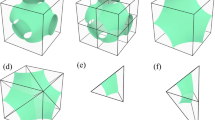Abstract
In the present paper, multi-scale concurrent topology optimization of material and structural design under mechanical and thermal loads is considered. To this end, the Porous Anisotropic Material with Penalization (PAMP) model which includes both microscopic material density and macroscopic material density as design variables, is employed to distribute material on two length scales in an optimal way. Corresponding problem formulation and numerical solution procedures are also developed and validated through a number of numerical examples. It is found that the proposed method is effective for the solution of concurrent material and structural optimization problems. Numerical evidences also suggest that compared with solid material, porous material with well-designed microstructure may be a better choice when thermo-elastic effects are considered.









Similar content being viewed by others
References
Deshpande VS, Fleck NA, Ashby MF (2001) Effective properties of the octet-truss lattice material. J Mech Phys Solids 49:1747–1769
Gibson LJ, Ashby MF (1997) Cellular solids: structure and properties. Cambridge University Press, Cambridge
Hutchinson RG, Wicks N, Evans AG, Fleck NA, Hutchinson JW (2003) Kagome plate structures for actuation. Int J Solids Struct 40(25):6969–6980
Zhang Y, Xue ZY, Qiu XM, Fang DN (2008) Plastic yield and collapse mechanism of planar lattice structures. J Mech Mater Struct 3(7):1257–1277
Rodrigues HC, Guedes JM, Bendsoe MP (2002) Hierarchical optimization of material and structure. Struct Multidiscipl Optim 24:1–10
Coelho PG, Fernandes PR, Guedes JM (2008) A hierarchical model for concurrent material and topology optimisation of three-dimensional structures. Struct Multidiscipl Optim 35(2):107–115
Liu L, Yan J, Cheng GD (2008) Optimum structure with homogeneous optimum truss-like material. Comput Struct 86(13):1417–1425
Rodrigues HC, Fernandes PR (1995) A material based model for topology optimization of thermoelastic structures. Int J Numer Meth Eng 38:1951–1965
Pedersen P, Niels NL (2010) Strength optimized designs of thermoelastic structures. Struct Multidiscipl Optim 42:681–691
Li Q, Steven GP, Xie YM (1999) Displacement minimization of thermoelastic structures by evolutionary thickness designs. Comput Methods Appl Mech Eng 179:361–378
Deaton JD, Grandhi RV (2013) Stiffening of restrained thermal structures via topology optimization. Struct Multidiscipl Optim 48:731–745
Gao T, Zhang WH (2010) Topology optimization involving thermo-elastic stress loads. Struct Multidiscipl Optim 42:725–738
Dems K, Mróz Z (1987) Variational approach to sensitivity analysis in thermoelasticity. J Therm Stress 10:283–306
Deng JD, Yan J, Cheng GD (2013) Multi-objective concurrent topology optimization of thermoelastic structures composed of homogeneous porous material. Struct Multidiscipl Optim 47(4):583–597
Sun SP, Zhang WH (2009) Topology optimal design of thermo-elastic structures. Acta Mech Sin 41(6):878–887
Radman A, Huang X, Xie YM (2014) Topological design of microstructures of multi-phase materials for maximum stiffness or thermal conductivity. Comput Mater Sci 91:266–273
Yan J, Yang SX, Duan ZY, Yang CQ (2015) Minimum compliance optimization of a thermoelastic lattice structure with size-coupled effects. J Therm Stress 38(3):338–357
Liu S, Cheng GD (1995) Homogenization-based method for predicting thermal expansion coefficients of composite materials. J Dalian Univ Technol 35(5):451–457
Guest JK, Prevost JH, Belytschko T (2004) Achieving minimum length scale in topology optimization using nodal design variables and projection functions. Int J Numer Meth Eng 61(2):238–254
Duan ZY, Yan J, Zhao GZ (2015) Integrated optimization of the material and structure of composites based on the Heaviside penalization of discrete material model. Struct Multidiscipl Optim 51(3):721–732
Yan J, Cheng GD, Liu L (2008) A uniform optimum material based model for concurrent optimization of thermoelastic structures and materials. Int J Simul Multi Design Optim 2(4):259–266
Zhang WH, Duysinx P (2003) Dual approach using a variant perimeter constraint and efficient sub-iteration scheme for topology optimization. Comput Struct 81:2173–2181
Bendsoe MP, Sigmund O (2003) Topology optimization: theory methods and applications. Springer-Verlag, Berlin
Acknowledgments
The financial support for this research was provided by the Program (11372060, 91216201) of NSFC, the Major National Science and Technology Project (2011ZX02403-002), 111 project (B14013), Program for Chang Jiang Scholars and Innovative Research Team in University (PCSIRT), and Fundamental Research Funds for the Central Universities (DUT14LK30). These supports are gratefully acknowledged.
Author information
Authors and Affiliations
Corresponding author
Rights and permissions
About this article
Cite this article
Yan, J., Guo, X. & Cheng, G. Multi-scale concurrent material and structural design under mechanical and thermal loads. Comput Mech 57, 437–446 (2016). https://doi.org/10.1007/s00466-015-1255-x
Received:
Accepted:
Published:
Issue Date:
DOI: https://doi.org/10.1007/s00466-015-1255-x




